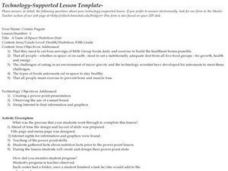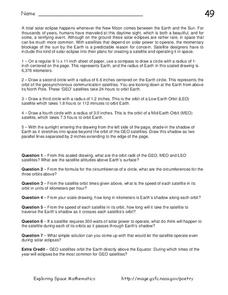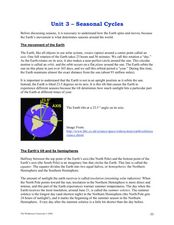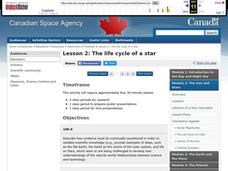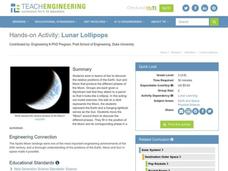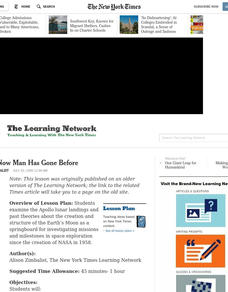Curated OER
(S-1) Sunlight and the Earth
Learners discuss the solar heating of the Earth and atmosphere, its heat loss proceses, and the way these relate to weather and climate.
Curated OER
Building an Ecologically Balanced Living Space
Students design and build an ecologically balanced living space based on the principles of an old growth forest. They take one part of a house (or structure in the community) and redesign it according to the principles of the forest cycle.
Curated OER
The Earth
In this earth fact worksheet, students look at a picture of the planet earth and read a list of accompanying facts, along with a brief paragraph.
Curated OER
A Taste of Space Nutrition Unit
Second graders make a power point presentation about space nutrition and health.
Tech Museum of Innovation
Analogous Models
What goes into a museum display? A secondary-level STEM project prompts groups to design a museum display for the Tech Museum of Innovation. They create an analogous, interactive model illustrating a science concept to complete the lesson.
Curated OER
This House is Made of Mud: Exploring the Shapes in Our Lives
Students study about our dependence on the earth's resources for materials. They practice their knowledge of geometric shapes by recognizing them in the context of the story.
EngageNY
TASC Transition Curriculum: Workshop 9
Here's a workshop for teachers that rocks the academic world! Using earthquakes as a medium for instruction, educators learn about crosscutting engineering with science. Fun, hands-on, collaborative exercises encourage participants to...
American Museum of Natural History
Journey to the Stars
Fifteen detailed pictures and informative captions delve deep into the exploration of stars—their life cycle and importance in the universe.
Curated OER
Why Do We Have Night?
Learners engage in a fun, creative way to discover how the Earth moves. This lesson helps students explain why there is day and night. It can also create curiosity to further study the solar system and eclipses!
Curated OER
TE Activity: Muscles, Muscles Everywhere
Young scholars study three different muscle types and investigate the affect of space travel on astronauts' muscles. They examine how exercise has a positive affect on muscle both on Earth and in space while looking at engineers' roles...
Curated OER
Solar Eclipse
In this solar eclipse worksheet, students solve seven problems about solar eclipses after making a model following five steps. They determine the different orbits for satellites, they determine the lengths of Earth's shadow and they find...
Curated OER
The Sun and Moon
Students understand basic concepts about Earth, the Sun and the Moon,
such as relative movement and the phases of the moon. Through discussion, looking at pictures, listening to Native American stories, observing, and building models,...
NASA
Auroras
In this auroras learning exercise, students define 11 terms related to space phenomena such as auroras, coronal mass ejections and auroral ovals. Students use a given website to help them define the terms and they write a 500 word essay...
Curated OER
WEAVING TECHNOLOGY INTO THEMATIC UNITS T.O.O.L.S. 2000
Third graders utilize computers and other technology to explain the solar system. Ten different stations involve students through laserdisc, research, art, GeoSafari, space toys, and the computer.
Curated OER
Creating Craters
Students explore parts of an impact crater and compare and contrast craters found in Earth, the Moon, and Mars. Crater formation is modelled and the relationship of mass, velocity, and size of the projectile to the crater formation is...
Curated OER
Making a Sundial
Third graders make a sundial and explain how to use it. They describe the movement of Earth and the moon and the apparent movement of other bodies through the sky. They predict what happens when they put their sundials in the sun.
Curated OER
Reason for the Seasons
Students study the seasons of the Earth. In this seasons instructional activity, students study the science of the seasons on Earth by studying the tilt and axis of the Earth's orbit. Students read background information and four...
Curated OER
Seasonal cycles
Students understand that the rotation of the Earth is responsible for the seasons. In this seasonal cycles lesson, students learn how the rotation of the Earth affects the seasons. Students answer questions about the rotation, the...
Curated OER
Student Exploration: Summer and Winter
In this recognizing the seasons online/interactive instructional activity, students explore the Earth's positions and determine the summer and winter season. Students answer 21 short answer questions
Curated OER
Follow the Sun
Students use a simple model of the Earth and Sun as seen from space to explore the sun's apparent movement across the sky over the course of a day and year. They consider the apparent direction of movement and changes in the sun's angle.
Curated OER
The Life Cycle of a Star
Students investigate the life cycle of a star and make conclusions based on evidence, research, and observation. In this lesson on space and scientific investigation, students describe the relationships between science and technology...
Curated OER
Lunar Lollipops
Students work with a partner, Styrofoam ball and light source to simulate the positions of the Earth, Moon and Sun at various stages during the phases of the Moon. They describe why the Moon is visible from Earth and complete a worksheet.
Curated OER
Where in the World Is All the Water?
Students investigate the distribution of the earth's water. They conduct a demonstration of water distribution, and create a pie graph to display the results.
Curated OER
Where Now Man Has Gone Before
Students examine the Apollo lunar landings and past theories about the creation and structure of the Earth's Moon as a springboard for investigating missions and milestones in space exploration since the creation of NASA in 1958.





